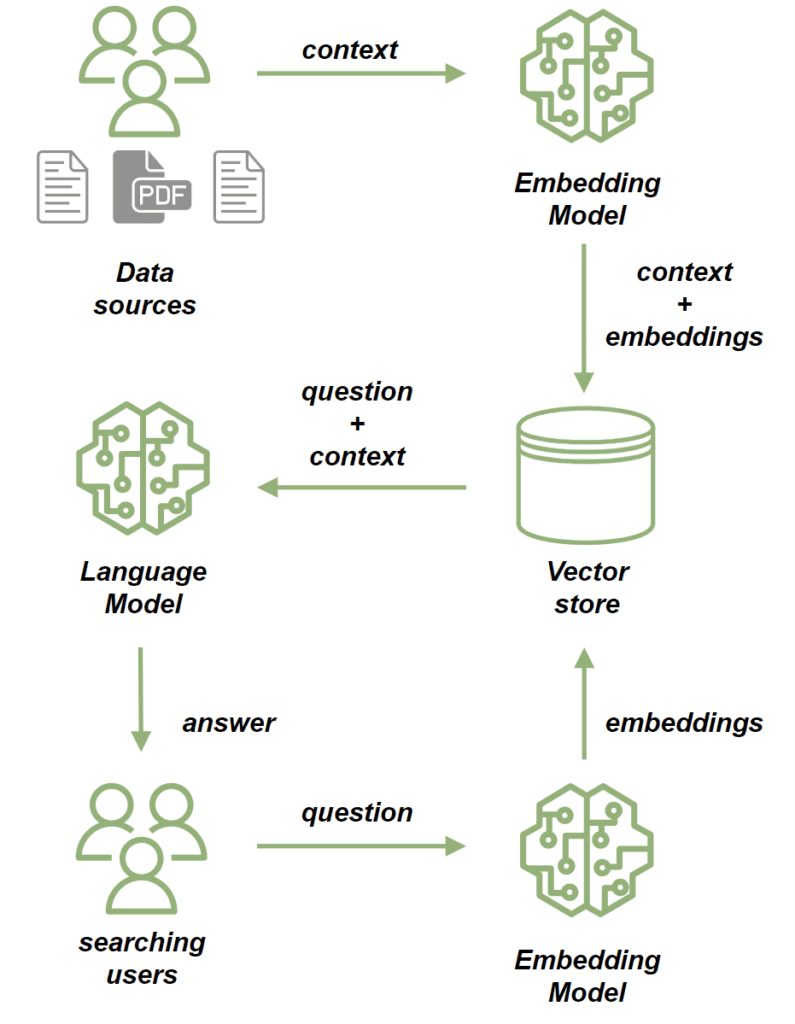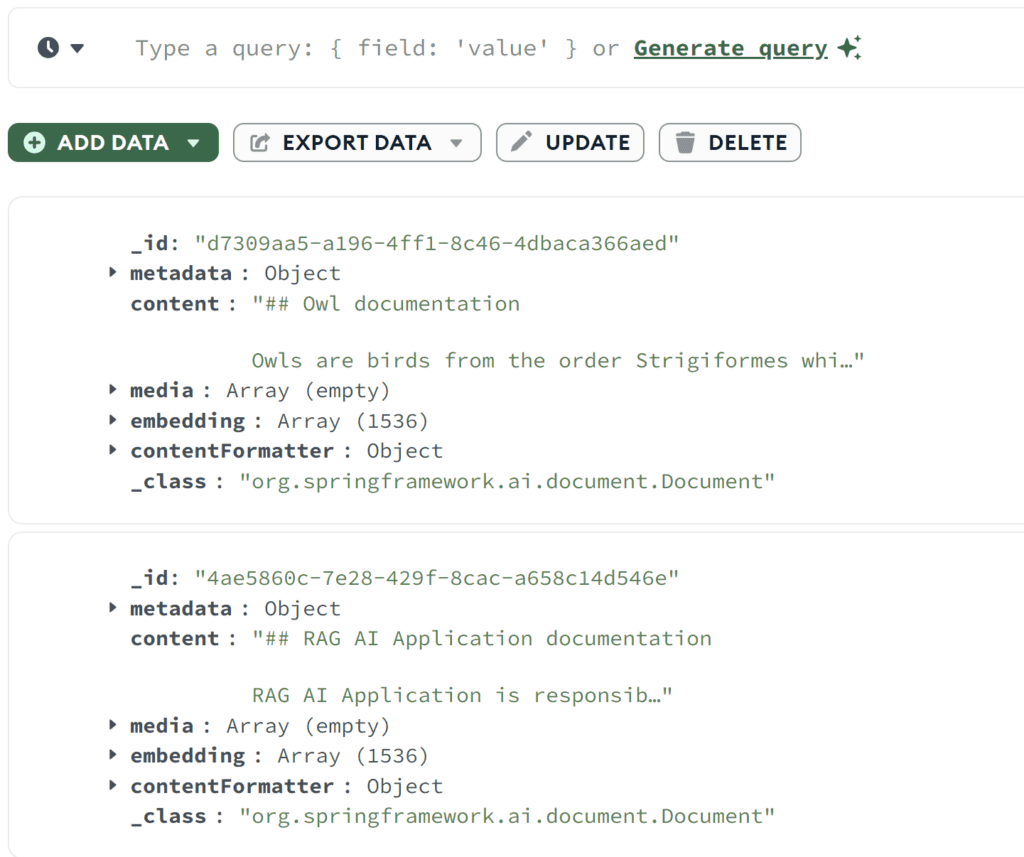1. 概述
人工智能技术的使用正在成为现代开发的一项关键技能,在本文中,我们将构建一个可以根据存储的文档回答问题的RAG Wiki应用程序。
我们将使用Spring AI将我们的应用程序与MongoDB Vector数据库和LLM集成。
2. RAG应用
当自然语言生成需要依赖上下文数据时,我们会使用检索增强生成(RAG)应用程序。RAG应用程序的一个关键组件是向量数据库,它在有效管理和检索这些数据方面发挥着至关重要的作用:

我们使用嵌入模型来处理源文档,嵌入模型将文档中的文本转换为高维向量。这些向量捕获内容的语义含义,使我们能够根据上下文(而不仅仅是关键字匹配)比较和检索相似内容,然后我们将文档存储在向量存储中。
保存文档后,我们可以通过以下方式根据它们发送提示:
- 首先,我们使用嵌入模型来处理问题,将其转换为捕捉其语义含义的向量。
- 接下来,我们执行相似性搜索,将问题的向量与存储在向量存储中的文档的向量进行比较。
- 从最相关的文档中,我们为问题构建了一个上下文。
- 最后,我们将问题及其上下文发送给LLM,LLM会构建与查询相关并通过提供的上下文进行丰富的响应。
3. MongoDB Atlas向量搜索
在本教程中,我们将使用MongoDB Atlas Search作为向量存储,它提供的向量搜索功能可以满足我们在此项目中的需求。为了设置MongoDB Atlas Search的本地实例以进行测试,我们将使用mongodb-atlas-local Docker容器,让我们创建一个docker-compose.yml文件:
version: '3.1'
services:
my-mongodb:
image: mongodb/mongodb-atlas-local:7.0.9
container_name: my-mongodb
environment:
- MONGODB_INITDB_ROOT_USERNAME=wikiuser
- MONGODB_INITDB_ROOT_PASSWORD=password
ports:
- 27017:27017
4. 依赖和配置
让我们首先添加必要的依赖,由于我们的应用程序将提供HTTP API,因此我们将包含spring-boot-starter-web依赖:
<dependency>
<groupId>org.springframework.boot</groupId>
<artifactId>spring-boot-starter-web</artifactId>
<version>LATEST_VERSION</version>
</dependency>
此外,我们将使用OpenAI API客户端连接到LLM,因此我们也添加它的依赖:
<dependency>
<groupId>org.springframework.ai</groupId>
<artifactId>spring-ai-openai-spring-boot-starter</artifactId>
<version>LATEST_VERSION</version>
</dependency>
最后,我们将添加MongoDB Atlas Store依赖:
<dependency>
<groupId>org.springframework.ai</groupId>
<artifactId>spring-ai-mongodb-atlas-store-spring-boot-starter</artifactId>
<version>LATEST_VERSION</version>
</dependency>
现在,让我们为应用程序添加配置属性:
spring:
data:
mongodb:
uri: mongodb://wikiuser:password@localhost:27017/admin
database: wiki
ai:
vectorstore:
mongodb:
collection-name: vector_store
initialize-schema: true
path-name: embedding
indexName: vector_index
openai:
api-key: ${OPENAI_API_KEY}
chat:
options:
model: gpt-3.5-turbo
我们指定了MongoDB URL和数据库,还通过设置集合名称、嵌入字段名称和向量索引名称配置了向量存储。借助initialize-schema属性,所有这些工件都将由Spring AI框架自动创建。
最后,我们添加了OpenAI API Key和模型版本。
5. 将文档保存到向量存储
现在,我们添加将数据保存到向量存储的过程。我们的应用程序将负责根据现有文档为用户问题提供答案-本质上是一种Wiki。
让我们添加一个模型,将文件内容与文件路径一起存储:
public class WikiDocument {
private String filePath;
private String content;
// standard getters and setters
}
下一步,我们将添加WikiDocumentsRepository。在这个Repository中,我们封装了所有持久层逻辑:
import org.springframework.ai.document.Document;
import org.springframework.ai.transformer.splitter.TokenTextSplitter;
@Component
public class WikiDocumentsRepository {
private final VectorStore vectorStore;
public WikiDocumentsRepository(VectorStore vectorStore) {
this.vectorStore = vectorStore;
}
public void saveWikiDocument(WikiDocument wikiDocument) {
Map<String, Object> metadata = new HashMap<>();
metadata.put("filePath", wikiDocument.getFilePath());
Document document = new Document(wikiDocument.getContent(), metadata);
List<Document> documents = new TokenTextSplitter().apply(List.of(document));
vectorStore.add(documents);
}
}
这里我们注入了VectorStore接口Bean,它将由spring-ai-mongodb-atlas-store-spring-boot-starter提供的MongoDBAtlasVectorStore实现。在saveWikiDocument方法中,我们创建一个Document实例并用内容和元数据填充它。
然后我们使用TokenTextSplitter将文档分成更小的块并将它们保存在我们的向量存储中,现在让我们创建一个WikiDocumentsServiceImpl:
@Service
public class WikiDocumentsServiceImpl {
private final WikiDocumentsRepository wikiDocumentsRepository;
// constructors
public void saveWikiDocument(String filePath) {
try {
String content = Files.readString(Path.of(filePath));
WikiDocument wikiDocument = new WikiDocument();
wikiDocument.setFilePath(filePath);
wikiDocument.setContent(content);
wikiDocumentsRepository.saveWikiDocument(wikiDocument);
} catch (IOException e) {
throw new RuntimeException(e);
}
}
}
在Service层,我们检索文件内容,创建WikiDocument实例,并将其发送到Repository进行持久保存。
在控制器中,我们只需将文件路径传递给Service层,如果文档保存成功,则返回201状态码:
@RestController
@RequestMapping("wiki")
public class WikiDocumentsController {
private final WikiDocumentsServiceImpl wikiDocumentsService;
// constructors
@PostMapping
public ResponseEntity<Void> saveDocument(@RequestParam String filePath) {
wikiDocumentsService.saveWikiDocument(filePath);
return ResponseEntity.status(201).build();
}
}
我们应该注意此端点的安全性方面,存在一个潜在的漏洞,用户可以使用此端点上传意外文件,例如配置或系统文件。作为解决方案,我们可以限制可以上传文件的目录。现在,让我们启动我们的应用程序并查看我们的流程如何工作。让我们添加Spring Boot Test依赖项,这将允许我们设置测试Web上下文:
<dependency>
<groupId>org.springframework.boot</groupId>
<artifactId>spring-boot-starter-test</artifactId>
<version>LATEST_VERSION</version>
</dependency>
现在,我们将启动测试应用程序实例并调用两个文档的POST端点:
@AutoConfigureMockMvc
@ExtendWith(SpringExtension.class)
@SpringBootTest
class RAGMongoDBApplicationManualTest {
@Autowired
private MockMvc mockMvc;
@Test
void givenMongoDBVectorStore_whenCallingPostDocumentEndpoint_thenExpectedResponseCodeShouldBeReturned() throws Exception {
mockMvc.perform(post("/wiki?filePath={filePath}",
"src/test/resources/documentation/owl-documentation.md"))
.andExpect(status().isCreated());
mockMvc.perform(post("/wiki?filePath={filePath}",
"src/test/resources/documentation/rag-documentation.md"))
.andExpect(status().isCreated());
}
}
两个调用都应返回201状态码,因此文档已添加。我们可以使用MongoDB Compass来确认文档已成功保存到向量存储中:

我们可以看到,两个文档都已保存。我们可以看到原始内容以及嵌入数组。
6. 相似性搜索
让我们添加相似性搜索功能,我们将在Repository中包含一个findSimilarDocuments方法:
@Component
public class WikiDocumentsRepository {
private final VectorStore vectorStore;
public List<WikiDocument> findSimilarDocuments(String searchText) {
return vectorStore
.similaritySearch(SearchRequest
.query(searchText)
.withSimilarityThreshold(0.87)
.withTopK(10))
.stream()
.map(document -> {
WikiDocument wikiDocument = new WikiDocument();
wikiDocument.setFilePath((String) document.getMetadata().get("filePath"));
wikiDocument.setContent(document.getContent());
return wikiDocument;
})
.toList();
}
}
我们从VectorStore调用了similaritySearch方法,除了搜索文本之外,我们还指定了结果限制和相似度阈值。相似度阈值参数允许我们控制文档内容与搜索文本的匹配程度。
在Service层,我们将代理对Repository的调用:
public List<WikiDocument> findSimilarDocuments(String searchText) {
return wikiDocumentsRepository.findSimilarDocuments(searchText);
}
在控制器中,让我们添加一个GET端点,接收搜索文本作为参数并将其传递给Service:
@RestController
@RequestMapping("/wiki")
public class WikiDocumentsController {
@GetMapping
public List<WikiDocument> get(@RequestParam("searchText") String searchText) {
return wikiDocumentsService.findSimilarDocuments(searchText);
}
}
现在让我们调用新的端点并看看相似性搜索如何工作:
@Test
void givenMongoDBVectorStoreWithDocuments_whenMakingSimilaritySearch_thenExpectedDocumentShouldBePresent() throws Exception {
String responseContent = mockMvc.perform(get("/wiki?searchText={searchText}", "RAG Application"))
.andExpect(status().isOk())
.andReturn()
.getResponse()
.getContentAsString();
assertThat(responseContent)
.contains("RAGAIApplication is responsible for storing the documentation");
}
我们调用了端点,搜索文本与文档中不完全匹配。但是,我们仍然检索了具有相似内容的文档,并确认其中包含我们存储在rag-documentation.md文件中的文本。
7. 提示端点
让我们开始构建提示流程,这是我们应用程序的核心功能。我们将从AdvisorConfiguration开始:
@Configuration
public class AdvisorConfiguration {
@Bean
public QuestionAnswerAdvisor questionAnswerAdvisor(VectorStore vectorStore) {
return new QuestionAnswerAdvisor(vectorStore, SearchRequest.defaults());
}
}
我们创建了一个QuestionAnswerAdvisor Bean,负责构建提示请求,包括初始问题。此外,它将附加向量存储的相似性搜索响应作为问题的上下文。现在,让我们将搜索端点添加到我们的API:
@RestController
@RequestMapping("/wiki")
public class WikiDocumentsController {
private final WikiDocumentsServiceImpl wikiDocumentsService;
private final ChatClient chatClient;
private final QuestionAnswerAdvisor questionAnswerAdvisor;
public WikiDocumentsController(WikiDocumentsServiceImpl wikiDocumentsService,
@Qualifier("openAiChatModel") ChatModel chatModel,
QuestionAnswerAdvisor questionAnswerAdvisor) {
this.wikiDocumentsService = wikiDocumentsService;
this.questionAnswerAdvisor = questionAnswerAdvisor;
this.chatClient = ChatClient.builder(chatModel).build();
}
@GetMapping("/search")
public String getWikiAnswer(@RequestParam("question") String question) {
return chatClient.prompt()
.user(question)
.advisors(questionAnswerAdvisor)
.call()
.content();
}
}
在这里,我们通过将用户的输入添加到提示并附加我们的QuestionAnswerAdvisor来构建提示请求。
最后,让我们调用我们的端点,看看它告诉我们有关RAG应用程序的信息:
@Test
void givenMongoDBVectorStoreWithDocumentsAndLLMClient_whenAskQuestionAboutRAG_thenExpectedResponseShouldBeReturned() throws Exception {
String responseContent = mockMvc.perform(get("/wiki/search?question={question}", "Explain the RAG Applications"))
.andExpect(status().isOk())
.andReturn()
.getResponse()
.getContentAsString();
logger.atInfo().log(responseContent);
assertThat(responseContent).isNotEmpty();
}
我们向端点发送了问题“Explain the RAG applications”并记录了API响应:
b.s.r.m.RAGMongoDBApplicationManualTest : I'm sorry, but the economic theory is not directly related to the information provided about owls and the RAG AI Application.
If you have a specific question about economic theory, please feel free to ask.
可以看到,端点根据我们之前保存在向量数据库中的文档文件返回了有关RAG应用程序的信息。
现在让我们尝试询问一些我们知识库中肯定没有的问题:
@Test
void givenMongoDBVectorStoreWithDocumentsAndLLMClient_whenAskUnknownQuestion_thenExpectedResponseShouldBeReturned() throws Exception {
String responseContent = mockMvc.perform(get("/wiki/search?question={question}", "Explain the Economic theory"))
.andExpect(status().isOk())
.andReturn()
.getResponse()
.getContentAsString();
logger.atInfo().log(responseContent);
assertThat(responseContent).isNotEmpty();
}
现在我们询问了经济理论,以下是答案:
b.s.r.m.RAGMongoDBApplicationManualTest : I'm sorry, but the economic theory is not directly related to the information provided about owls and the RAG AI Application.
If you have a specific question about economic theory, please feel free to ask.
这次,我们的应用程序没有找到任何相关文档,也没有使用任何其他来源来提供答案。
8. 总结
在本文中,我们成功使用Spring AI框架实现了一个RAG应用程序,该框架是集成各种AI技术的绝佳工具。此外,MongoDB被证明是处理向量存储的强大选择。
通过这种强大的组合,我们可以构建用于各种目的的基于现代人工智能的应用程序,包括聊天机器人、自动化维基系统和搜索引擎。
Post Directory
